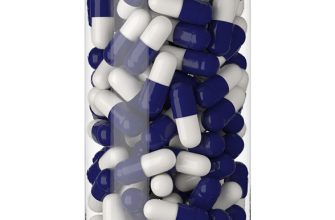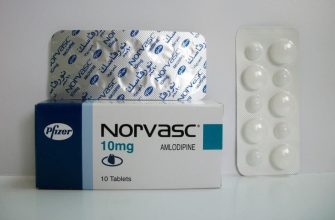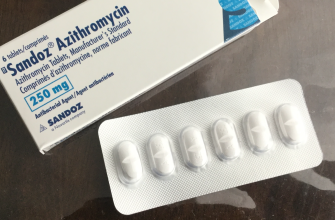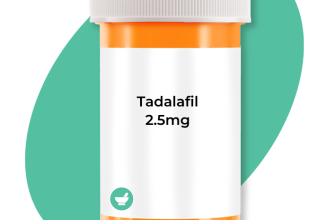Cephalexin serves as a reliable option for treating various bacterial infections, particularly those affecting the skin, respiratory system, and urinary tract. This cephalosporin antibiotic shows effectiveness against a range of strains, making it a go-to choice in many medical cases. Patients experiencing conditions such as cellulitis or otitis media often find significant relief with prescribed cephalexin.
In skin infections, cephalexin targets bacteria responsible for conditions like impetigo and abscesses. It works by inhibiting the cell wall synthesis of these microbes, thereby eliminating their infectious potential. This action not only alleviates symptoms but also promotes faster recovery.
For those with upper respiratory tract infections, cephalexin can effectively manage acute bacterial bronchitis and sinusitis. The antibiotic’s ability to penetrate body tissues allows it to reach the infection site and combat invading bacteria. Always consult a healthcare provider for appropriate dosage and duration to maximize treatment success while minimizing any potential side effects.
Additionally, cephalexin plays a role in treating urinary tract infections (UTIs). It combats uropathogenic strains, offering relief from painful symptoms. Its oral form provides convenience, which enhances patient adherence to the treatment regimen. Choose cephalexin as a dependable option for bacterial infections as instructed by your doctor.
- Prescription Uses of Cephalexin
- Administration Guidelines
- Possible Side Effects
- Understanding Cephalexin: An Overview
- Administration and Dosage
- Potential Side Effects
- Common Indications for Cephalexin Prescription
- Dosage Guidelines for Cephalexin in Adult Patients
- Pediatric Use: Cephalexin Dosage Considerations
- Cephalexin for Skin and Soft Tissue Infections
- Indications for Use
- Dosing Guidelines
- Utilizing Cephalexin for Respiratory Tract Infections
- Indications and Administration
- Side Effects and Considerations
- Potential Side Effects and Drug Interactions of Cephalexin
- Importance of Completing Cephalexin Treatment Course
Prescription Uses of Cephalexin
Cephalexin is commonly prescribed to treat a variety of bacterial infections. Medical professionals often recommend this antibiotic for the following conditions:
- Skin Infections: Cephalexin effectively combats skin infections caused by susceptible bacteria, including cellulitis and impetigo.
- Respiratory Tract Infections: It is frequently used to address pneumonia and bronchitis stemming from bacterial agents.
- Bone Infections: In cases of osteomyelitis, cephalexin may be part of a treatment regimen to control infection.
- Ear Infections: It provides relief for acute otitis media in children and adults by targeting the bacteria responsible.
- Urinary Tract Infections: Physicians often prescribe cephalexin for uncomplicated UTIs caused by specific bacteria.
Administration Guidelines
Cephalexin is typically taken orally in capsule or liquid form. For maximum absorption, it’s advisable to take it with food. Dosage varies, so adhere to the prescribed regimen closely. Complete the full course, even if symptoms improve, to prevent resistance.
Possible Side Effects
While many tolerate cephalexin well, some may experience side effects such as:
- Nausea and vomiting
- Diarrhea
- Allergic reactions like rash or hives
If severe reactions occur, such as difficulty breathing, seek immediate medical care.
Understanding Cephalexin: An Overview
Cephalexin serves as a widely prescribed antibiotic effective against various bacterial infections. It belongs to the cephalosporin class of antibiotics and works by inhibiting bacterial cell wall synthesis, leading to cell death. Healthcare providers recommend cephalexin to treat conditions such as pneumonia, ear infections, skin infections, and urinary tract infections.
Administration and Dosage
Typically, cephalexin is taken orally in capsule or liquid form. The dosage varies based on the patient’s age, weight, and severity of the infection. Adults usually receive 250 mg to 1 g every 6 hours, while children’s doses are calculated based on weight. Always follow the prescribing instructions and complete the full course to prevent resistance.
Potential Side Effects
Side effects may occur, though not everyone experiences them. Common reactions include nausea, vomiting, diarrhea, and abdominal pain. Allergic reactions, though rare, can manifest as rashes, itching, or swelling. Seek medical advice if severe side effects or allergic reactions arise.
| Condition Treated | Common Dosage |
|---|---|
| Pneumonia | 500 mg every 8 hours |
| Skin Infections | 250 mg to 1 g every 6 hours |
| Urinary Tract Infections | 500 mg every 12 hours |
| Ear Infections | 500 mg every 8 hours |
Consult a healthcare provider for personalized advice and adjustments based on individual health needs. Proper usage of cephalexin enhances treatment outcomes and reduces the risk of complications.
Common Indications for Cephalexin Prescription
Cephalexin is often prescribed for a range of bacterial infections. It is effective against infections caused by specific bacteria, making it a preferred choice in various situations.
One common indication is skin infections, including cellulitis and infected wounds. These conditions typically manifest with redness, swelling, and pain. Cephalexin treats the underlying bacterial infection effectively.
Urinary tract infections (UTIs) also respond well to this antibiotic. Symptoms include frequent urination, burning sensation during urination, and lower abdominal pain. Doctors frequently prescribe cephalexin for uncomplicated UTIs.
Another indication involves respiratory tract infections, such as pneumonia and bronchitis. Cephalexin targets bacterial pathogens responsible for these illnesses, alleviating symptoms like cough and difficulty breathing.
Bone infections, or osteomyelitis, may also require cephalexin. Physicians prescribe it to manage infections that affect the bones, particularly in patients with existing health issues or after surgical procedures.
Below is a table summarizing the common indications for cephalexin prescription:
| Indication | Description |
|---|---|
| Skin Infections | Effective for cellulitis and infected wounds. |
| Urinary Tract Infections | Used for uncomplicated UTIs with typical symptoms. |
| Respiratory Tract Infections | Targets bacterial pneumonia and bronchitis. |
| Bone Infections | Prescribed for managing osteomyelitis. |
Cephalexin is often paired with other treatments to enhance recovery and prevent complications. Always consult a healthcare provider for appropriate diagnosis and treatment options.
Dosage Guidelines for Cephalexin in Adult Patients
The typical dosage for cephalexin in adult patients varies based on the type of infection. For uncomplicated infections, a common starting dose is 250 mg to 500 mg taken every 6 hours. For more severe infections, a higher dose may be prescribed, ranging from 500 mg to 1 g every 6 hours. Always adhere to the recommendations provided by your healthcare provider.
In cases of kidney impairment, dosage adjustments are necessary. For patients with moderate renal impairment, a reduction in the dose or an increase in the interval between doses might be required. Regular monitoring of renal function is essential in these situations to avoid adverse effects.
Treatment duration generally spans from 7 to 14 days, depending on the severity and type of infection being treated. Follow your healthcare provider’s instructions regarding the length of treatment to ensure the effectiveness of the medication.
Cephalexin capsules or tablets should be taken with a full glass of water, preferably on an empty stomach, for better absorption. If gastrointestinal upset occurs, you may take it with food. Consuming the medication consistently at the same times daily helps maintain an effective level in the bloodstream.
For skin and soft tissue infections, a dose of 500 mg every 12 hours may be recommended for a period of 10 days. Adjustments may be made based on clinical response and tolerability.
In the case of bacterial infections, timely treatment initiation is vital. Do not discontinue the medication prematurely, even if symptoms improve, to prevent the development of antibiotic resistance.
Pediatric Use: Cephalexin Dosage Considerations
For children, the recommended dosage of cephalexin typically ranges from 25 mg to 50 mg per kilogram of body weight per day, divided into two to four doses. This helps ensure optimal efficacy while minimizing potential side effects.
Adjust the dosage based on the severity of the infection. For mild infections, consider the lower end of the dosage range. For more severe infections, increase the dosage to the upper limit, ensuring the total daily amount does not exceed 4 grams.
Cephalexin can be administered with or without food, but taking it with food may reduce gastrointestinal discomfort. When using the liquid formulation, shake the bottle well before measuring the dose. Consider using an oral syringe for precise dosing.
Monitor for any allergic reactions, especially in patients with a history of penicillin allergy, as cross-reactivity can occur. Parents should report any signs of rash, difficulty breathing, or swelling immediately.
For pediatric patients with renal impairment, adjust dosages accordingly. Assess renal function frequently to avoid potential toxicity. Regular follow-up appointments can help ensure treatment efficacy and make any necessary dosage adjustments.
Keep all medications out of children’s reach and follow the physician’s instructions on duration of therapy. Completion of the full course is essential to prevent the recurrence of the infection.
Cephalexin for Skin and Soft Tissue Infections
Cephalexin is prescribed to treat various skin and soft tissue infections caused by bacteria. It effectively combats conditions like cellulitis, wound infections, and abscesses. Its ability to target bacteria makes it a reliable choice for these types of infections.
Indications for Use
- Cellulitis: Cephalexin addresses bacterial skin infections, reducing swelling and tenderness.
- Wound infections: It helps clear infections resulting from surgical wounds or traumatic injuries.
- Abscesses: Cephalexin can support the treatment of abscesses, aiding in the control of bacteria.
Dosing Guidelines
Dosage often varies based on the severity of the infection and patient factors. Typical dosing for adults may range from 250 mg to 500 mg taken every 6 hours. Always adhere to the healthcare provider’s recommendations for dosage and duration to ensure optimal results.
It’s important to complete the full course of medication, even if symptoms improve before the treatment ends. This practice helps prevent bacterial resistance and recurrence of the infection.
Monitor for side effects, including gastrointestinal discomfort or allergic reactions. If any severe symptoms arise, seek medical advice immediately. Cephalexin generally provides a safe and effective option for managing skin and soft tissue infections when used as directed.
Utilizing Cephalexin for Respiratory Tract Infections
Cephalexin serves as a reliable option for addressing bacterial respiratory tract infections, particularly those caused by susceptible organisms. It effectively targets conditions such as pneumonia and bronchitis when prescribed appropriately. Dosage typically involves 500 mg every 6 to 12 hours, depending on the severity of the infection and patient characteristics. Always consult a healthcare provider for personalized dosing recommendations.
Indications and Administration
Cephalexin is particularly useful for treating infections caused by specific Gram-positive bacteria, including Streptococcus pneumoniae. The drug works by disrupting bacterial cell wall synthesis, leading to cell lysis and elimination of the infection. Understanding when to utilize cephalexin is vital. For minor infections, it may be appropriate; for more severe cases, additional antibiotics may be necessary. Follow the prescribed course completely, even if symptoms improve before finishing the medication.
Side Effects and Considerations
Monitor for potential side effects, which may include gastrointestinal disturbances, allergic reactions, or interactions with other medications. Patients with a history of penicillin allergies should inform their healthcare provider, as cross-reactivity can occur. Regular check-ups can help assess the effectiveness of treatment and any adjustments needed for optimal recovery. Cephalexin is a trusted choice in managing respiratory tract infections, contributing significantly to patient care.
Potential Side Effects and Drug Interactions of Cephalexin
The use of cephalexin can lead to various side effects. Some common reactions include:
- Gastrointestinal disturbances such as nausea, vomiting, and diarrhea.
- Allergic reactions that may manifest as rash, itching, or swelling.
- Fatigue or general weakness.
Less common but serious side effects may involve:
- Severe skin reactions including Stevens-Johnson syndrome.
- Changes in blood count such as decreased white blood cells or platelets.
- Liver enzyme elevations, indicating potential liver issues.
Monitor for any unusual symptoms and consult a healthcare professional immediately if they occur.
Cephalexin may interact with other medications, which alters its effectiveness or increases the risk of adverse effects. Significant interactions include:
- Probenecid, which can increase cephalexin levels in the blood, enhancing side effects.
- Anticoagulants such as warfarin, potentially increasing bleeding risk.
Always inform your doctor about all medications, supplements, and herbal products you are taking to prevent interactions. Regularly reviewing your medication with a healthcare provider ensures safe and effective treatment.
Importance of Completing Cephalexin Treatment Course
Complete the full course of cephalexin as prescribed. Doing so maximizes its effectiveness against the bacterial infection being treated. Stopping treatment early may lead to persistent bacteria, increasing the risk of relapse or complications.
If you stop taking cephalexin prematurely, not only can your symptoms return, but you may also contribute to antibiotic resistance. This phenomenon occurs when bacteria adapt and become less sensitive to the antibiotic, making future infections harder to treat.
Adhere to the prescribed schedule, even if symptoms improve before finishing the medication. Regularly taking the drug ensures that all bacteria are effectively eliminated, preventing the development of resistant strains and achieving a complete recovery.
Set reminders to maintain your medication routine. If you miss a dose, take it as soon as possible unless it’s almost time for your next scheduled dose. Never double up to compensate for a missed one. Keeping an uninterrupted treatment cycle maximizes the chances of successful eradication of the infection.
If you experience side effects, consult your healthcare provider before discontinuing use. They may suggest alternatives or adjustments that allow you to complete the course safely.
Following your doctor’s instructions ensures the best possible outcome for your health. Prioritize finishing your cephalexin treatment to promote full recovery and prevent future health issues.










